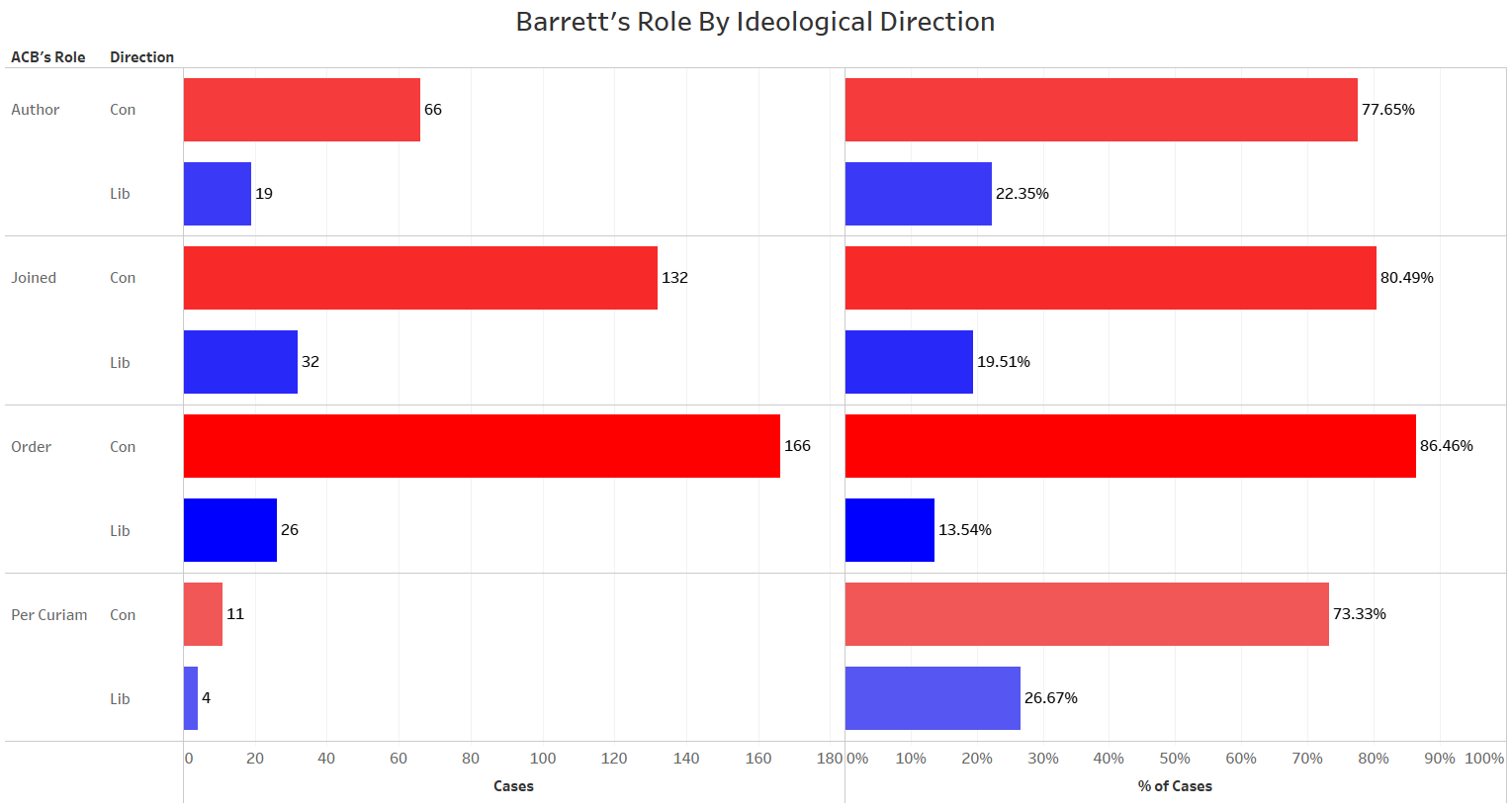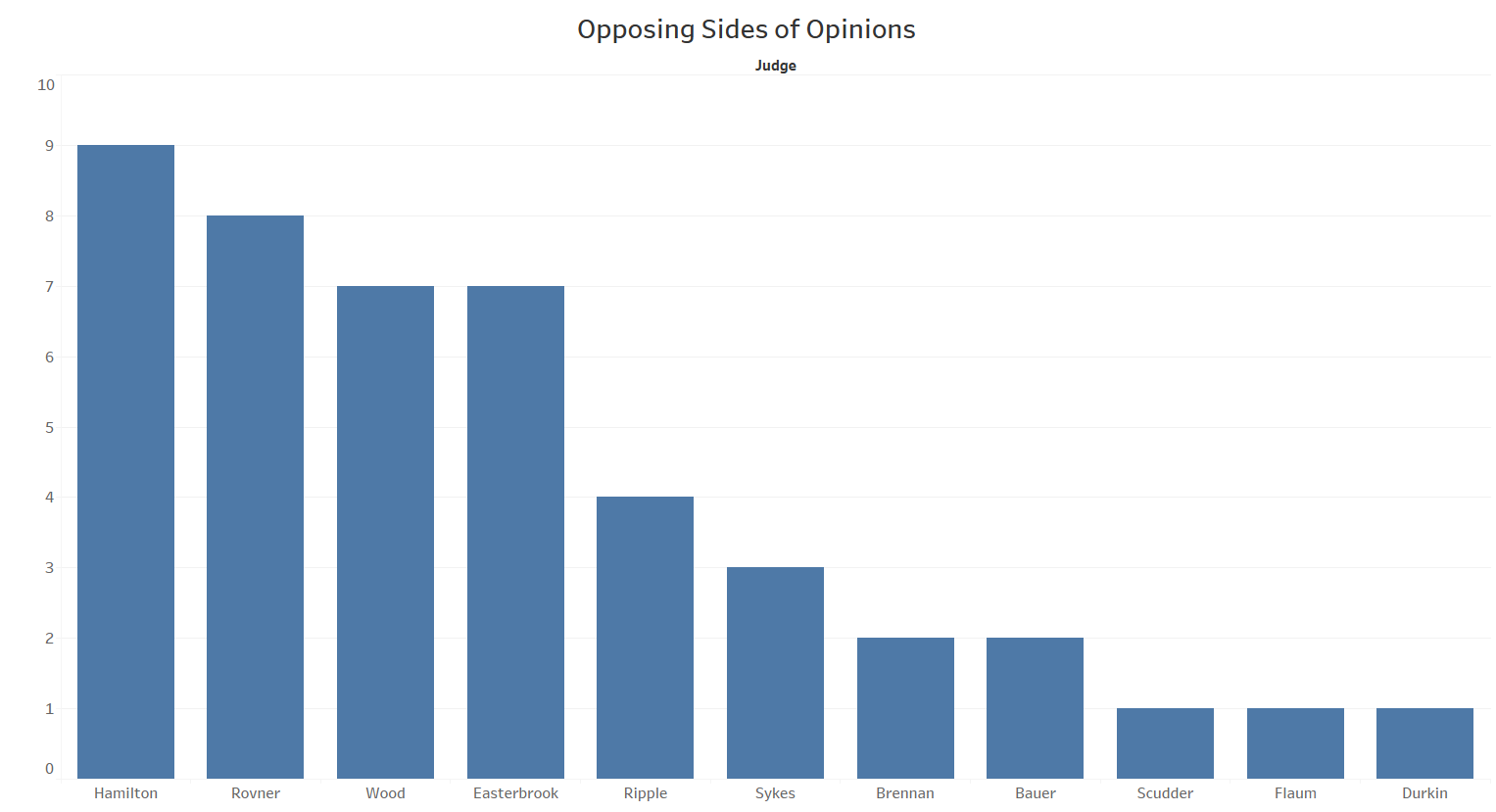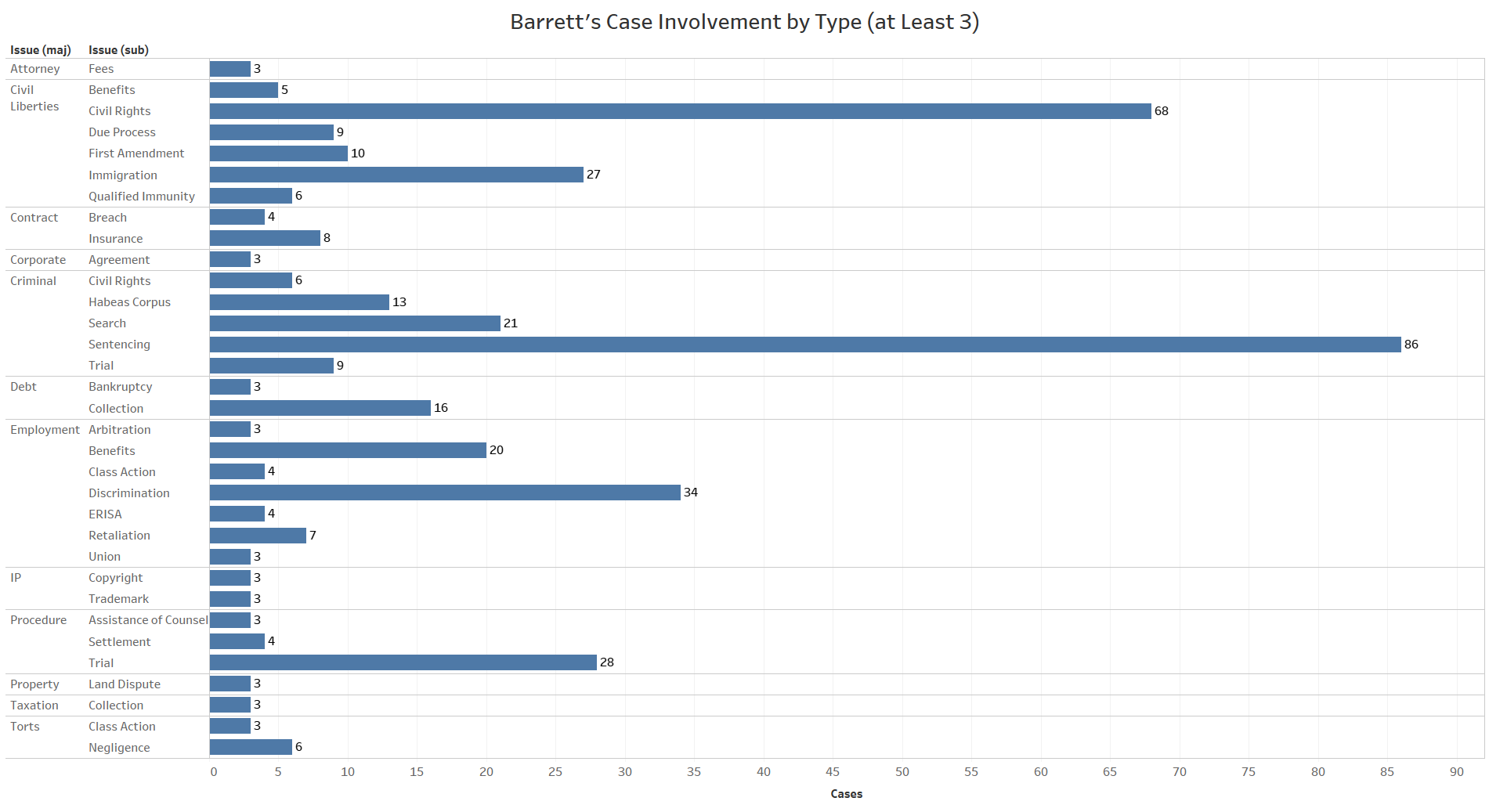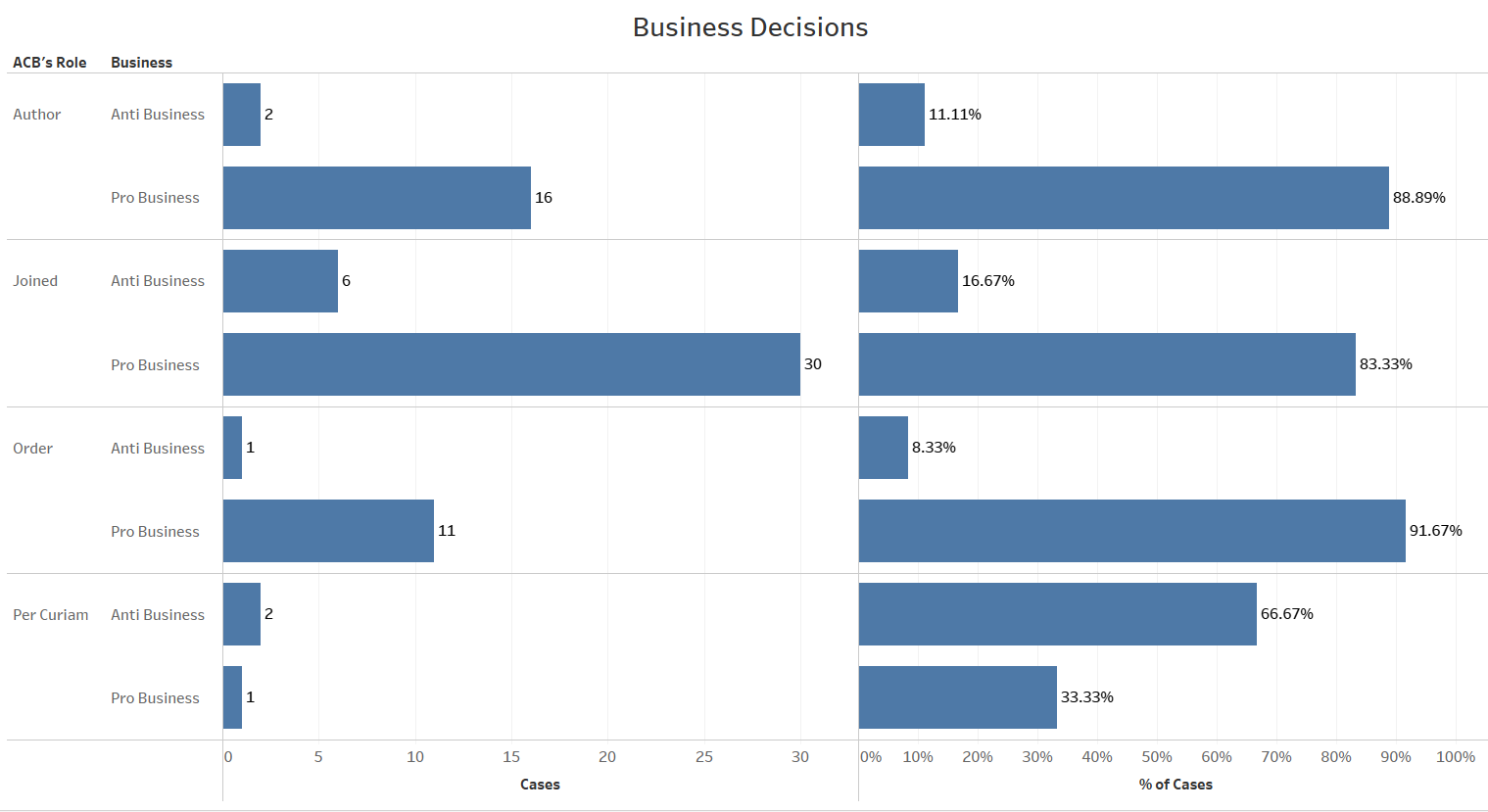Empirical SCOTUS: A comprehensive look at Judge Amy Coney Barrett


Judge Amy Coney Barrett, now a Supreme Court nominee, has followed a well-worn path of nominees before her. President Donald Trump nominated her to the U.S. Court of Appeals for the 7th Circuit on Nov. 2, 2017. He then nominated her to the Supreme Court, just under three years later, on Sept. 26, 2020. Chief Justice John Roberts, nominated by President George W. Bush to the U.S. Court of Appeals for the District of Columbia Circuit, similarly served less than three years as an appeals court judge before Bush nominated him to the Supreme Court.
While it may come as no surprise to see Barrett as the current nominee, her work during her limited time on the 7th Circuit is worthy of study, and this article undertakes to do so with a complete sample of the decisions in which Barrett was involved. Barrett participated in approximately 622 cases on the 7th Cicuit that produced written opinions or orders across a slew of issue areas. Barrett herself authored around 100 majority, concurring and dissenting opinions. (Case counts are based on distinct opinions. The counts in this article and dataset differ from those on the 7th Circuit’s website, as those are based on docket numbers and thus provide duplicate opinions when one opinion resolved multiple docket entries.)
7th Circuit judges
How can we unpack Barrett’s decision making? One way is by looking at whom she judged alongside. Eleven judges sit on the 7th Circuit, along with three senior judges and the occasional district judge sitting by designation. Of the 14 regular and senior judges, 12 were appointed by Republican presidents, while two were appointed by Democratic presidents. We can see the frequencies with which Barrett sat on panels with the other circuit judges below. In parentheses are the parties of each judge’s appointing president and the appointing president’s initials.

One way to skim the surface of Barrett’s decision making is to see which judges she disagreed with most often. This measure captures either when Barrett dissented from another judge’s decision or when another judge dissented from an opinion Barrett authored.

As would be expected from a Republican-nominated conservative judge, although Barrett sat on panels with Judges Diane Wood and David Hamilton — the two judges nominated by Democratic presidents — third and fifth most frequently, she disagreed with them first and third most often. Of the sitting circuit judges nominated by Republican presidents, Barrett disagreed with Ilana Rovner most often and with Michael Brennan least often.
Case area
Following mainly the coding for issue area from the United States Supreme Court Database, Barrett’s cases were coded into general and specific issue areas. (A sample of 30 cases was used to test for the reliability and validity of the coding through an intercoder reliability test. Professor Jordan Carr Peterson of North Carolina State University was the second coder in this endeavor. The similarity in coding for 219 data points in this 30-case sample was 98.6%. A kappa test for intercoder agreement showed with the highest significance level that we can reject the hypothesis that coding choices were determined randomly.) The first purpose of this coding was to observe the split in case type of all of the cases that Barrett helped decide while sitting on the 7th Circuit.

Most decisions issued by federal appeals-court panels are in criminal cases, and Barrett’s tenure on the 7th Circuit was no exception. She decided more criminal-sentencing cases than any other case type. Civil rights cases were the second most common, and many of these had to do with prisoners’ treatment while in jails. Interestingly though, when summed up, Barrett decided the same number of civil liberties and criminal cases, at 141 apiece.
The specific issue areas that came up next most frequently were trial procedure, employment discrimination and immigration. The five most prevalent general issue areas, after criminal and civil liberties cases, were employment with 86 decisions, court procedure with 44, debt-related decisions with 20 and contract and tort decisions with 16 each.
Barrett’s authored and joined opinions and orders in these cases had real world implications. One area that many people are concerned with is her business decisions. These were coded broadly as decisions affecting business liability, contracts and deals.
An example of such a decision was in the case Burlaka v. Contract Transport Services LLC, where Barrett authored the majority opinion for the panel. In Burlaka, “truck drivers … brought individual, collective, and class action claims against Contract Transport Services (CTS), their former employer, for failing to provide overtime pay in violation of the Fair Labor Standards Act (FLSA), which requires overtime pay for any employee who works more than forty hours in a workweek.” The district court ruled against the drivers on the grounds that they were engaged in interstate commerce and thus exempt from FLSA. In her opinion, Barrett resoundingly agreed: “These facts plainly demonstrate that at least some spotters drove trailers carrying finalized goods destined for out-of-state delivery. Such a service, even if purely intrastate and interrupted briefly, would nevertheless constitute ‘driving in interstate commerce’ because it would be part of the goods’ continuous interstate journey.” This case presents an example of one of Barrett’s pro-business decisions in which she ruled against the employees and in favor of the business entity.
Barrett’s decisions were coded as pro-big business when a business entity was the clear victor or when a large corporate entity was successful against a much smaller business entity. Barrett’s decisions in this domain were split into opinions she authored, opinions she joined, unsigned orders and unsigned per curiam opinions.

Barrett was pro-business in all opinion types except per curiam opinions, of which there were only three. This puts her in territory similar to many of the current Supreme Court justices. Conservative judges tend to rule more frequently in favor of big business, although the reason for this differs a bit between Supreme Court justices and court of appeals judges. On the Supreme Court, there is more gray area, due to the many petitions filed at the court and the justices’ wide discretion as to which cases they hear. Conversely, court of appeals judges hear many more cases on mandatory appeal and affirm lower-court decisions more often. This fact, along with the percentage of Republican-nominated judges on the 7th Circuit, might help explain Barrett’s high likelihood of ruling in favor of big business.
Decision direction
A question on many peoples’ minds is where Barrett will fit on the court’s ideological spectrum if she is confirmed. Of course, some of this speculation is beyond the reach of empirical methods. Although research has examined how circuit court judges may alter their decision making in hopes of being elevated to the Supreme Court, the bulk of Supreme Court cases differ in a variety of ways from circuit court cases, and circuit court judges are constrained by precedent in ways that Supreme Court justices are not.
Even accounting for these differences, some have tried to bridge ideology between Supreme Court justices and appeals court judges using a variety of methods. The truth is that we can’t really know where Barrett would fall on the Supreme Court before she gets there because of the different voting incentives and constraints between the two court levels. We can, however, analyze Barrett’s ideological trends on the 7th Circuit by measuring the decision direction of her votes based on a measure for decision direction by the U.S. Supreme Court Database.
This coding takes into account the issue area, litigant type and judge’s vote. To give some background on the coding decisions, in the areas of criminal procedure, civil rights, First Amendment, due process, privacy, and attorneys, a vote is coded as liberal if it is: pro-person accused or convicted of a crime, or denied a jury trial; pro-civil liberties or civil rights claimant; pro-child or juvenile; or pro-indigent person (among other things). In cases dealing with unions and economic activity, a vote is coded as liberal if it is pro-union — except in union antitrust cases, in which a vote is coded as liberal if it is pro-competition, pro-government, anti-business or anti-employer. Cases that do not fall neatly into these ideological bins remain uncoded.
An example of an outcome coded as conservative is Shakman v. Clerk of Circuit Court of Cook County, in which Barrett authored an opinion dismissing a suit brought by a union for lack of jurisdiction because the union did not intervene to acquire membership into the plaintiff class. Conversely, Barrett authored an opinion coded as “liberal” in United States v. Watson, in which she held that an anonymous tip did not establish reasonable suspicion sufficient for the police to conduct a Terry stop.
We can look at Barrett’s ideology from several perspectives. One perspective is to see whether her ideology is consistent across cases in which she is the opinion author, she joins an opinion and the opinion is unsigned.

Barrett is most conservative in cases with unsigned orders. This is consistent with the theory that judges issue orders in cases with little dispute about the outcome. Oftentimes these decisions are summary or near-summary affirmances of lower court decisions, primarily in criminal cases. As these “easier” decisions are often in cases in which the evidence clearly shows the guilt of the accused, they tend to fall in favor of the government and so the outcome is generally coded as “conservative.”
Notwithstanding orders though, Barrett shows a high rate of ruling for conservative outcomes in all types of decisions. This across-the-board conservatism was likely a convincing factor in her nomination, even if this conservatism was measured qualitatively rather than through statistical inquiry. In essence then, this quantitative endeavor either supplants or at least helps to buffer the image of Barrett as a steadfast conservative vote on the 7th Circuit.
The data on Barrett’s decision making can be observed from different perspectives as well. An important way to assess how she might rule as a Supreme Court justice is by breaking down decisions into their constituent issue areas. The following figure looks at the ideological directions of Barrett’s decisions broken down by major issue area.

Although several of the issue areas contain only a handful of cases, the areas on the top of the figure cover a multitude of cases and all point toward a conservative ideological leaning. In issue areas with five or more cases, Barrett voted at least 75% of the time in a conservative direction. In contract and intellectual property cases, 100% of Barrett’s decisions were conservative. Of the areas with five or more cases, the only area in which she voted conservatively under 80% of the time was in civil liberties cases, at 76.12%. If Barrett is confirmed and remains consistent in her votes, we can expect her to line up with her fellow conservative justices.
Barrett was tapped for Trump’s third nomination to the Supreme Court because of an assessment of her decision making, among other characteristics. Other telling studies of Barrett’s decision making look at handfuls of cases and are thus limited mainly to the opinions she authored. The data for this article, encompassing all of Barrett’s decisions, give a novel quantitative picture of her decision making and ideological proclivities. The findings above reinforce the view that Barrett has been a consistent conservative vote on the 7th Circuit, but they also display the range of decisions and panels she was involved in. The dataset on which this article was based will also be made available on EmpiricalSCOTUS.com prior to Barrett’s confirmation hearings.
This article was originally published at Empirical SCOTUS.